NEWTON’S THIRD LAW OF MOTION
If a finger wearing roller skates stands facing a wall and pushes the wall with his hands , the finger finds himself moving backwards , away from the wall ( see Figure 26 ) . It appears as if the wall also pushes the finger away . Actually , when the boy exerts a force on the wall by pushing it with his hands , then the wall exerts an equal force on the finger in the opposite direction . Since the boy is wearing roller skates , the opposite
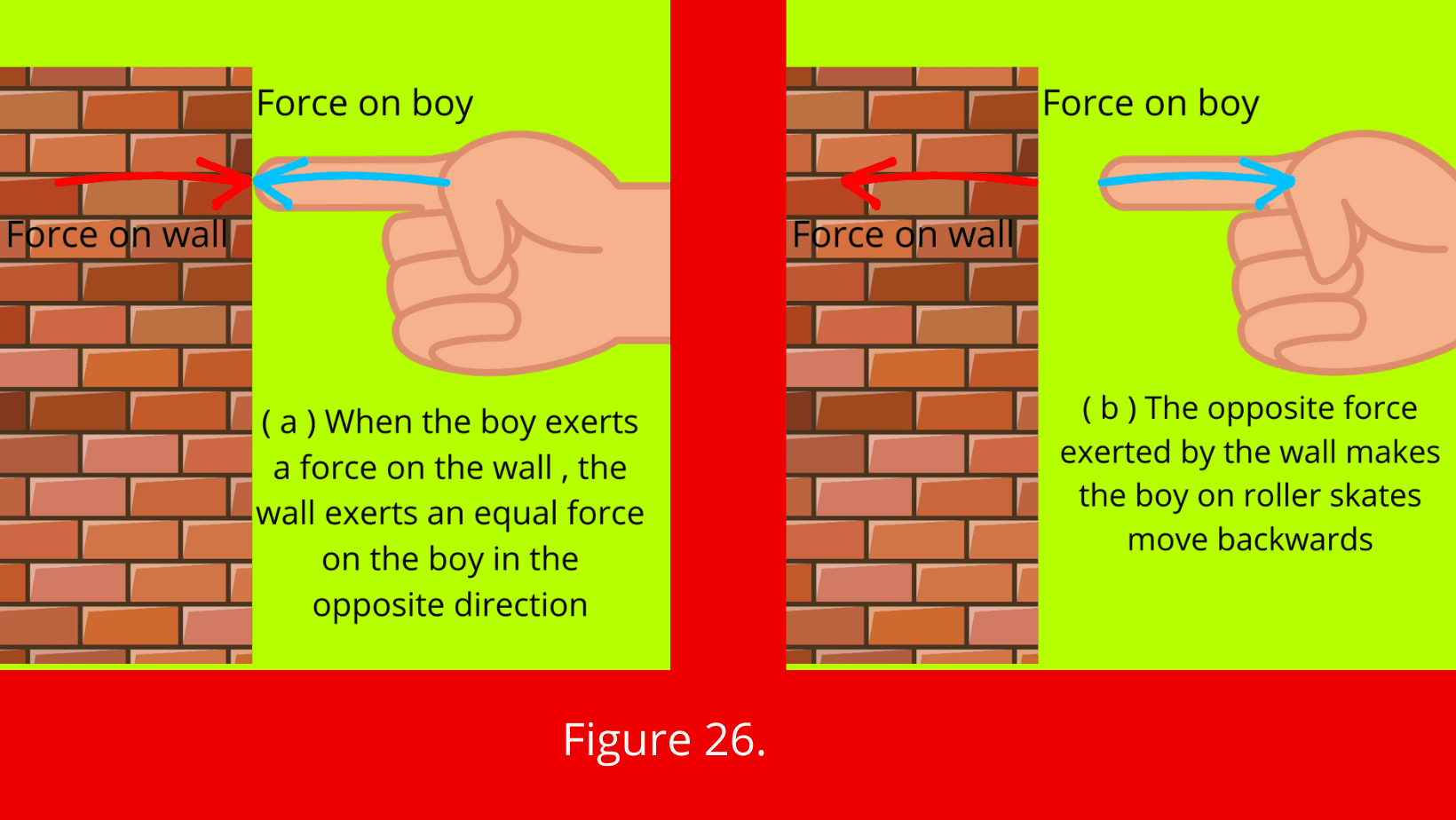
force exerted by the wall makes him move backwards . In Figure 26 ( a ) , the finger on roller skates is exerting force on the wall towards left side . The wall exerts an equal force on the boy towards right side . Due to this , the finger moves backwards to the right side [ see Figure 26 ( b ) ] . From this discussion we conclude that when a finger exerts a force on the wall , the wall exerts an equal and opposite force on the finger . This is just an illustration of Newton’s third law of motion .
When one body influences another body by applying force , we say that the first body is interacting with the second body . In any interaction between two bodies , there are always two forces that come into play . And Newton’s third law of motion describes the relationship between the forces that come into play when the two bodies interact with one another .
According to Newton’s third law of motion : Whenever one body exerts a force on another body , the second body exerts an equal and opposite force on the first body . The force exerted by the first body on the second body is known as ” action ” and the force exerted by the second body on the first body is known as ” reaction ” . It should be noted that ” action ” and ” reaction ” are just forces . We can now write another definition of Newton’s third law of motion : To every action there is an equal and opposite reaction . Action ( force ) and reaction ( force ) act on two different bodies , but they act simultaneously . We will now describe a simple experiment to prove the Newton’s third law of motion , that is , to prove that action ( force ) and reaction ( force ) are always equal and opposite .
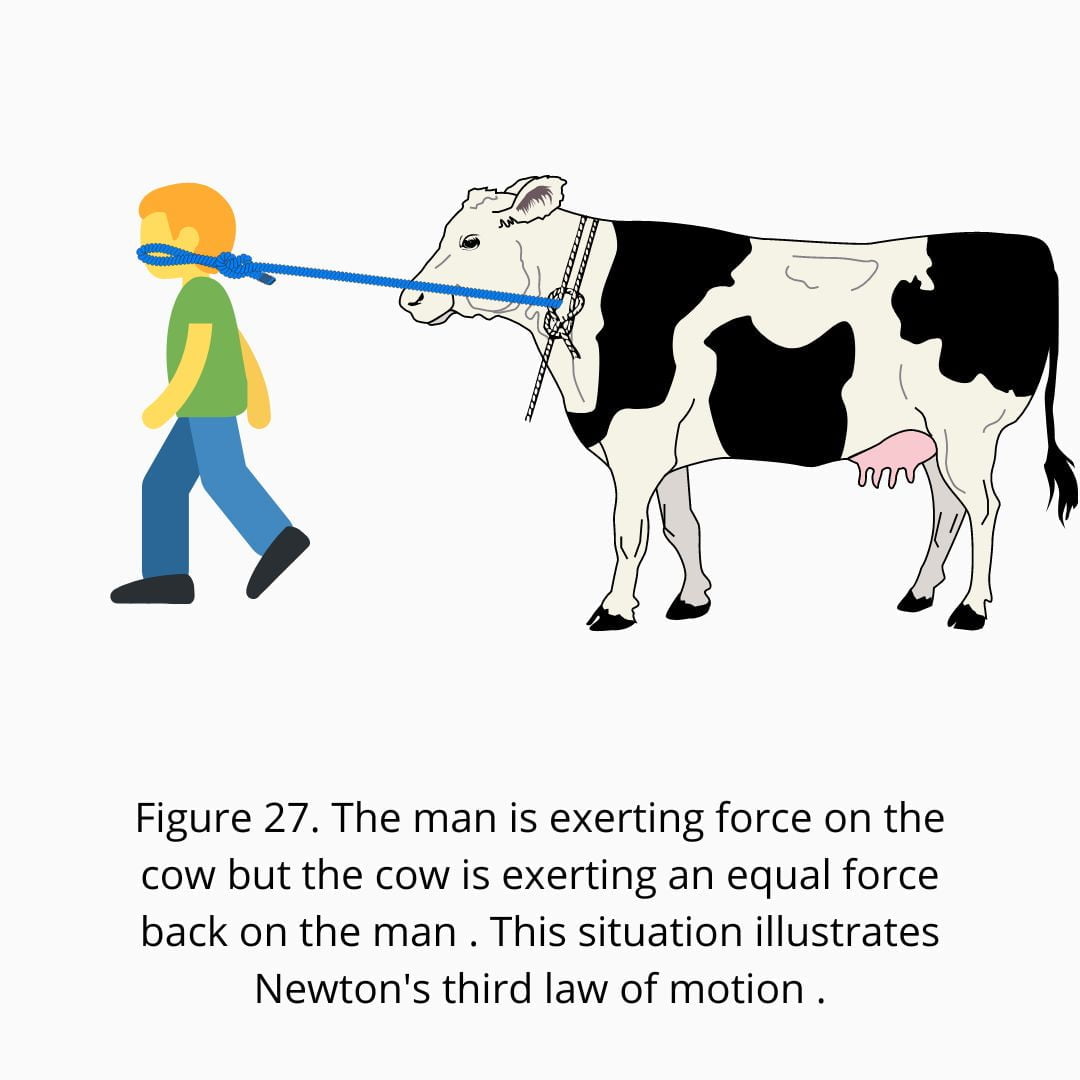
We take two similar spring balances A and B and join them hook to hook as shown in Figure 28. The other end of spring balance B is attached to a hook H fixed in a wall . Let us pull the free end of the spring
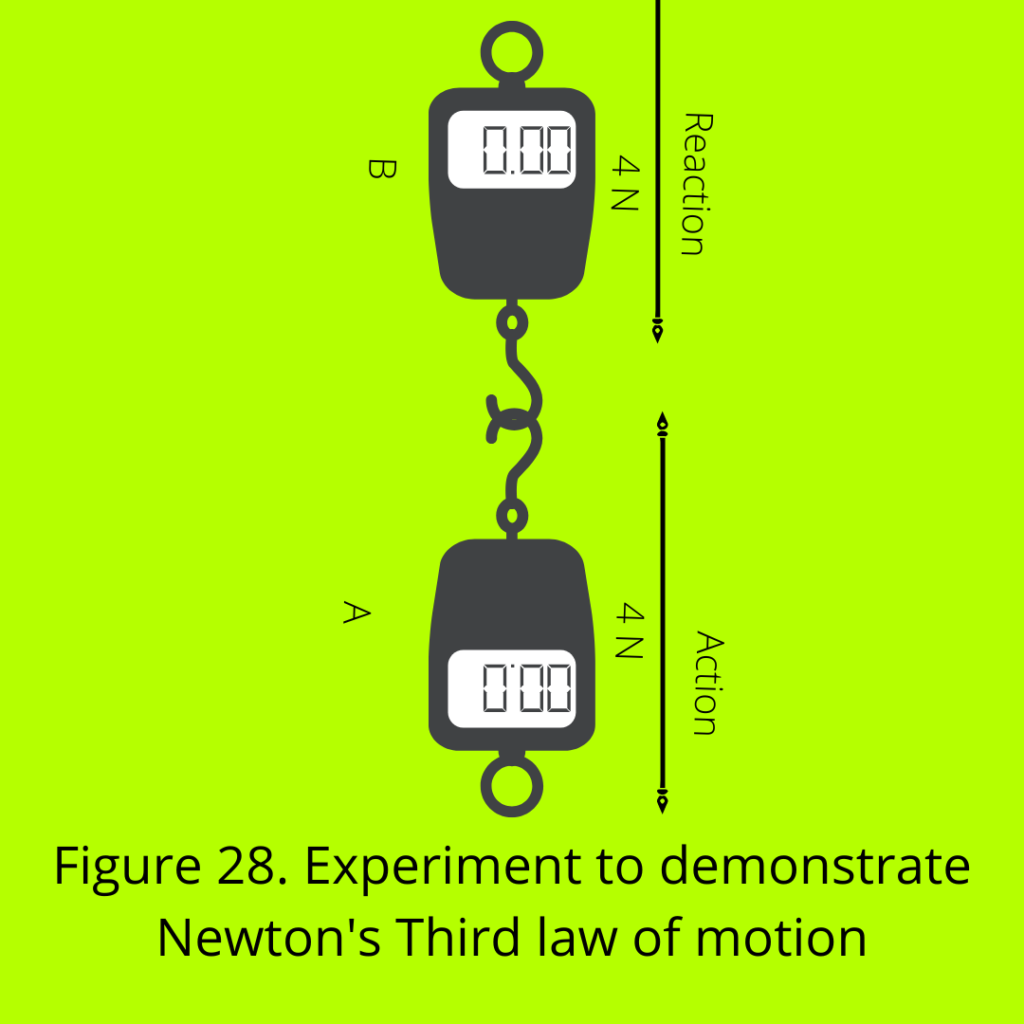
balance A to the right side by our hand . We find that both the spring balances show the same reading . For example , in Figure 28 , both the spring balances show the same force of 4 N. This can be explained as follows .
When we pull the balance A , it exerts a force of 4 N on the balance B. The balance B pulls the balance A with an equal force of 4 N , but in the opposite direction . In other words , when balance A exerts a force of action on balance B , then balance B exerts an equal and opposite force of reaction on balance A. Since both the spring balances show the same reading ( of 4 N ) , we conclude that the action and reaction forces are equal in magnitude . In Figure 28 we find that the action force is acting towards east and the reaction force is acting towards west . Thus , action and reaction forces act in opposite directions .
Action and Reaction Act on Two Different Bodies
Suppose a box is resting on the ground ( Figure 29 ) . The box is exerting a downward force of its weight on the ground . The downward weight of the box is balanced by an equal , upward force supplied by the ground . Now , the force exerted by the weight of the box is ” action ” and it acts on the ground whereas the force exerted by the ground on the box is ” reaction ” and it acts on the box . Since the box is in equilibrium under the action of two forces , it neither goes up nor goes down , the ” action ” of the box must be equal and opposite to the ” reaction ” of the ground . It is obvious that the ” action ” of the box acts on the ground and ” reaction ” of the ground acts on the box . Thus , action and reaction act on two different bodies .
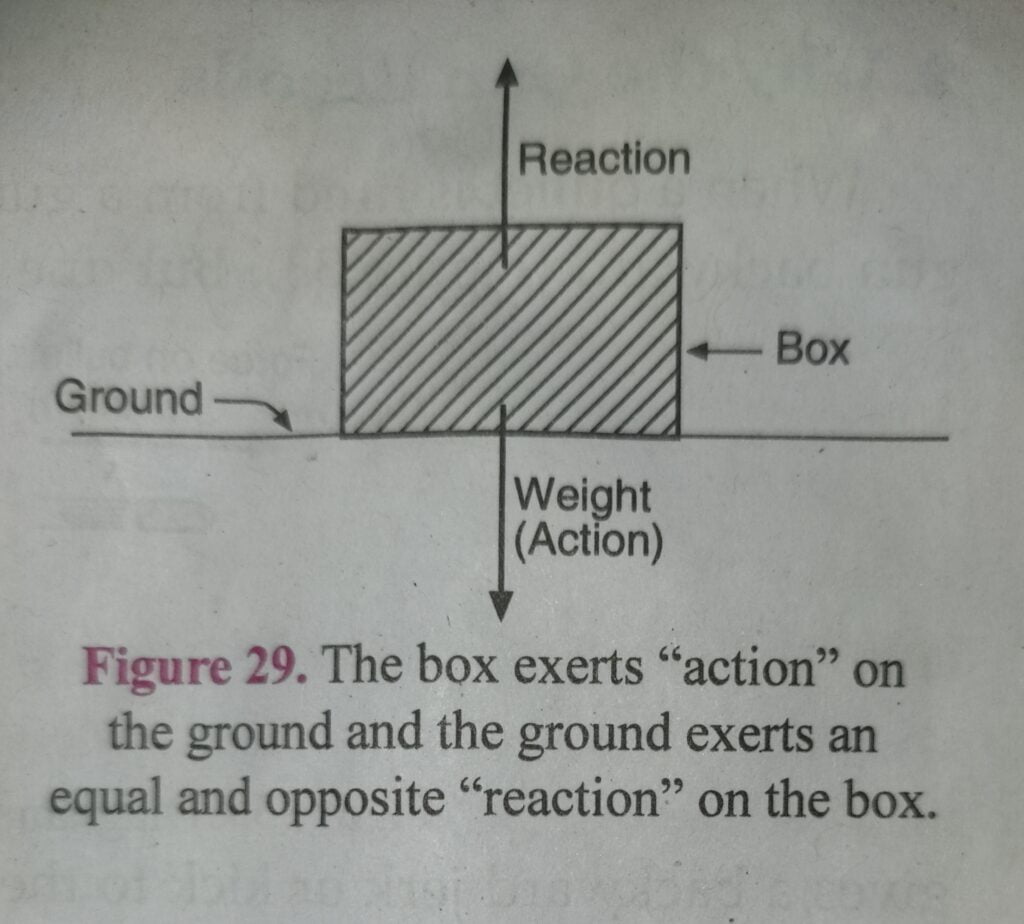
Some Examples to Illustrate Newton’s Third Law of Motion
We will now give some examples from our everyday life which will illustrate Newton’s third law of motion .
1. How do We Walk
When we walk on the ground , then our foot pushes the ground backward and , in return , the ground pushes our foot forward ( Figure 30 ) . The forward reaction exerted by the ground on our foot makes us

walk forward . If , however , the ground is slippery or if there is all ice , it becomes very difficult to walk . This is due to the fact that on the slippery ground or ice , the friction is much less , and we cannot exert a backward action force on slippery ground or ice which would produce a forward reaction force on us .
Let us discuss the case of a swimmer now . A swimmer pushes the water backwards ( or applies force on the water backwards ) with his hands and feet to move in the forward direction in water . It is the equal and opposite reaction to this force which pushes the swimmer forward .
Please note that though action and reaction forces are equal in magnitude but they do not produce equal acceleration in the two bodies on which they act . This is because the two bodies on which action and reaction forces act usually have different masses . So , the acceleration produced will be more in the body having less mass whereas the acceleration produced will be less in the body having more mass . This point will become more clear from the following example of the recoil of a gun on firing . ‘ Recoil ‘ of gun means ‘ sudden backward movement ‘ or ‘ jerk ‘ of gun when a bullet is fired from it .
2 Why the Gun Recoils
When a bullet is fired from a gun , the force sending the bullet forward is equal to the force sending the gun backward ( Figure 33 ) . But due to high mass of the gun , it moves only a little distance backward and.

gives a backward jerk or kick to the shoulder of the gunman . The gun is said to have recoiled .
3. The Flying of Jet Aeroplanes and Rockets
Jet aeroplanes utilise the principle of action and reaction . In the modern jet aircraft , the hot gases obtained by the rapid burning of fuel rush out of a jet ( a nozzle ) at the rear end ( back end ) of the aircraft at a great speed . The equal and opposite reaction of the backward going gases pushes the aircraft forward at a great speed .
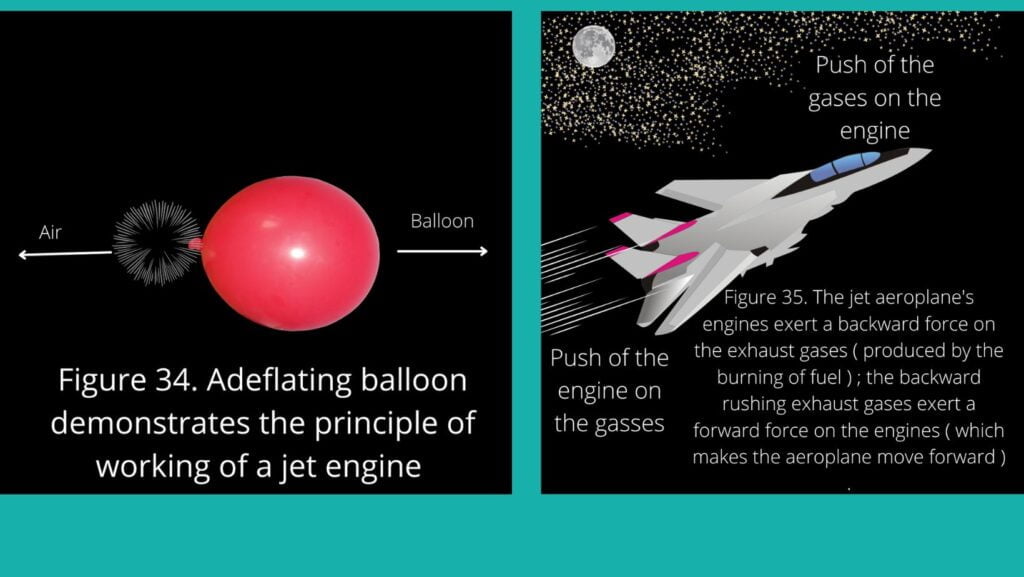
We can demonstrate the principle of working of a jet engine by using a balloon filled with compressed air as follows : If a balloon filled with compressed air and its mouth untied is released with its mouth on the left side , the balloon moves very fast towards the right side ( see Figure 34 ) . This means that the balloon flies off in the opposite direction to that of the escaping air . Here the compressed air present in balloon rushes to the left side with a high speed . The equal and opposite reaction of the left going air pushes the balloon to the right side .
Please note that if the inflated balloon is released with its mouth in the downward direction , then it will move upwards ( like a rocket ) ( see Figure 36 ) . In this case , the air rushes out of balloon in the downward direction . The equal and opposite reaction of downward going air pushes the balloon upwards . We will now discuss the case of rockets . The rockets also work on the principle of action and reaction . In a rocket , the hot gases produced by the rapid burning of fuel rush out of a jet at the bottom of the rocket at a very high speed ( Figure 37 ) . The equal and opposite reaction force of the downward going gases pushes the rocket upward with a great speed . Please note that a rocket can propel itself even in vacuum ( or outer space ) because it does not require air for obtaining uplift or for burning its fuel . This is not so in the case of a jet aircraft . A jet aircraft cannot fly in outer space ( where there is no air ) because it needs air to provide an uplift and also to burn its fuel .
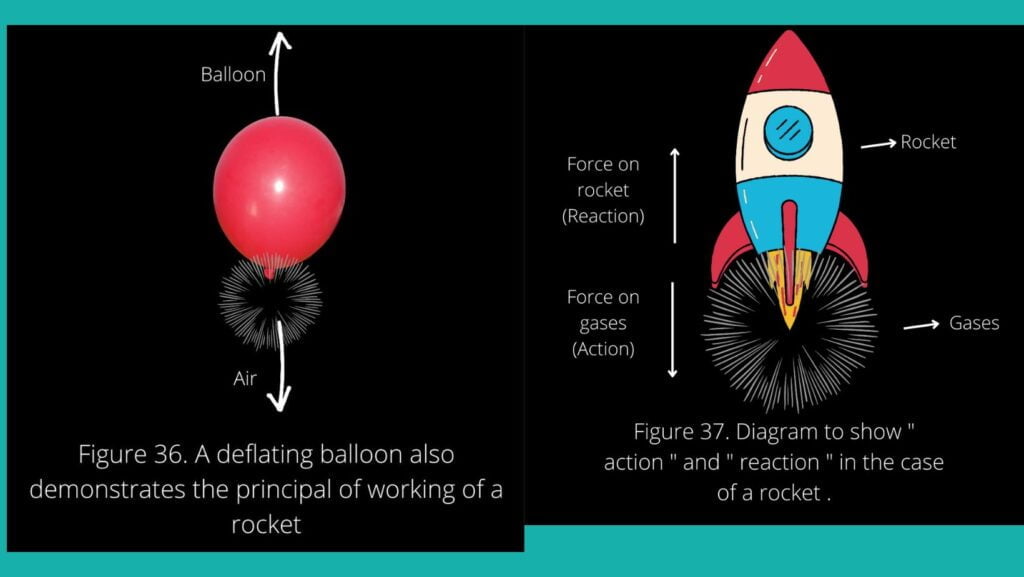
4. The Case of a Boat and the Ship
During the rowing of a boat , the boatman pushes the water backwards with the oars . The water exerts an equal and opposite push on the boat which makes the boat move forward . In fact , harder the boatman pushes back the water with oars , greater is the reaction force exerted by water and faster the boat moves forward .
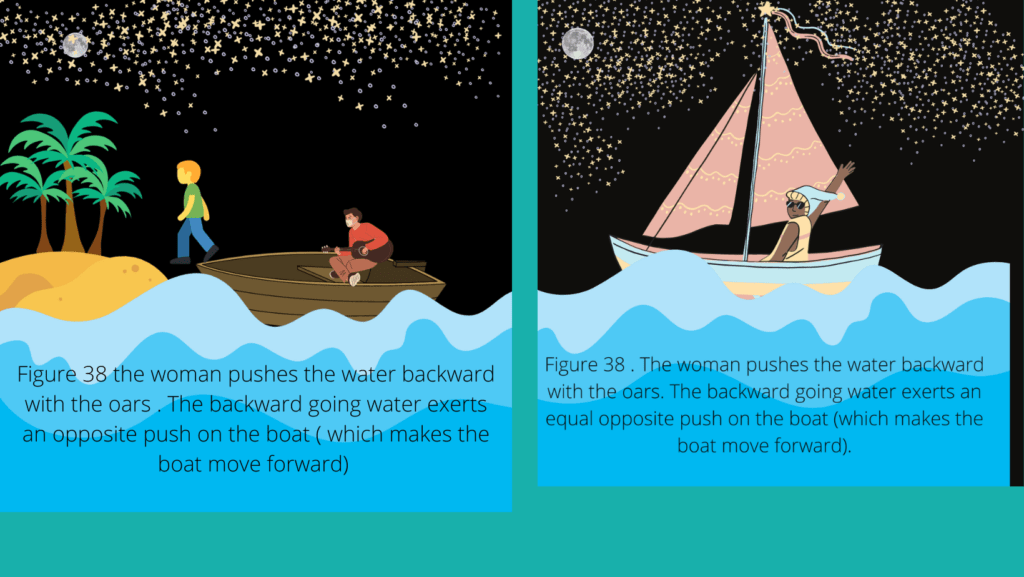
It is a common experience that when a man jumps out of a boat to the bank of the river ( or lake ) , the boat moves backwards , away from him . This is due to the fact that to step out of the boat , the man presses the boat with his foot in the backward direction ( Figure 39 ) . The push of the man on the boat is the action ( force ) . The boat exerts an equal force on the man in the forward direction which enables him to move forward . This force exerted by the boat on the man is reaction ( force ) . Since the boat is floating on water and not fixed , it moves backward due to the action force exerted by man .
Another point to be noted is that when a boatman wants to take the boat away from the bank of the river , he sits in the boat and pushes the river bank with his oar . When the boatman exerts a force of action on the bank ( with his oar ) , the bank exerts an equal and opposite force of reaction on the boat . So , the boat moves away from the bank .
The propellers of a ship are at its back end . When these propellers work , they exert a backward force on water in the sea . The equal and opposite reaction ( force ) exerted by water on the ship , moves the ship forward .
5. The Case of Hose Pipe
when firemen are directing a powerful stream of water on fire from a hose pipe, they have to hold the hose pipe strongly because of its tendency to go backward . The backward movement of the hose pipe is When firemen are directing a powerful stream of water on fire from a hose pipe , they have to hold the due to the backward reaction of water rushing through it in the forward direction at a great speed .
6. The Case of Horse Pulling a Cart
Let us apply the third law of action and reaction to the situation of a horse pulling a cart . According to the third law of motion , the horse exerts some force on the cart , and the cart exerts an equal and opposite force on the horse . So , at first glance it seems that the forces being equal and opposite cancel out and hence the cart would not move . But it should be noted that it is only the force on the cart which determines whether the cart will move or not , and that the force exerted by the cart on the horse affects the horse alone . Thus , if the horse is able to apply enough force to overcome the frictional forces present , the cart will move . So , to make the cart move , the horse bends
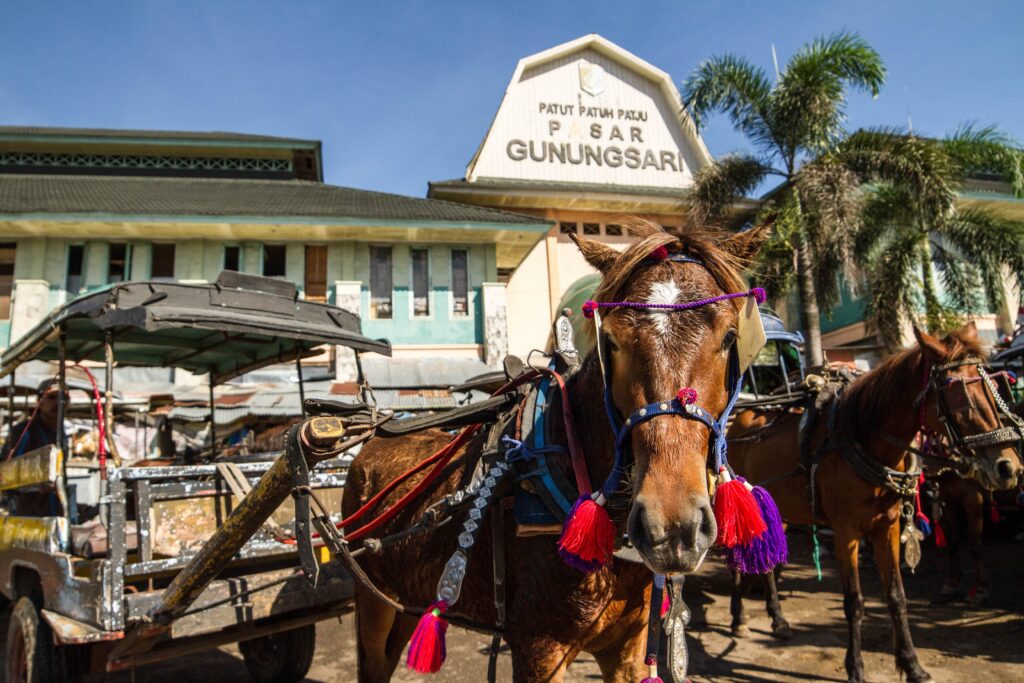
forward and pushes the ground with its feet . When the forward reaction to the backward push of the horse is greater than the opposing frictional forces of the wheels , the cart moves .
In all the above examples , the two interacting bodies are in direct contact with each other . It is not always necessary that two bodies can exert force on one another only when they are in contact . In some cases the two bodies can also exert force on each other even when they are not in contact with each other . That is , the interaction can also take place even when the two bodies are not in contact . In all such cases the forces of action and reaction are equal and opposite . For example , a magnet can interact with a piece of iron and exert a force on it even when they are separated by a distance . The magnet exerts a force on iron piece , and the iron piece exerts an equal and opposite force on the magnet . The interaction between an electrically charged comb and a piece of paper also takes place from a distance . The electrically charged comb and the piece of paper exert equal and opposite forces on each other . The interaction between a falling stone and the earth also takes place though they are not in contact with each other and two forces come into play . While the earth pulls the stone downwards by the force of gravity , the stone also pulls the earth towards itself with an equal force . It should be clear by now that we cannot think of a single isolated force – for every force there is an equal and opposite force . In other words , the forces always occur in pairs , and Newton’s third law of motion concerns these pairs of forces
